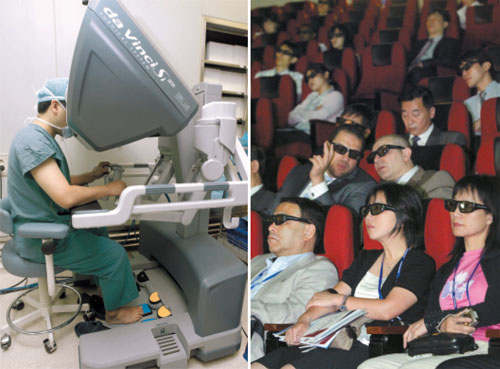Korea’s prowess with robotic surgery on display

Professor Choi Gi-hong, left, of Yonsei University’s Severance Hospital in Seoul performs an operation yesterday while, right, doctors from 10 different countries watch a live broadcast of the surgery in 3-D. By Kim Do-hoon
In an auditorium on the sixth floor of Yonsei University’s Severance Hospital in Seoul, about a hundred doctors from 10 different countries don clunky 3-D glasses, getting ready to view not a Hollywood blockbuster but live, 3-D images of an operation being performed on the fifth floor of the same building.
Professor Choi Gi-hong was performing a robotic liver resection on a 40-year-old man with colon cancer, because the cancer spread to the patient’s liver. All of the visiting doctors were able to witness the exact same image in 3-D that Dr. Choi was seeing as he performed the surgery.
Korea’s advances in robotic surgery were on show this week as about 600 doctors from across the country and abroad registered for a three-day “Yonsei Severance Da Vinci Live” symposium, which is running from yesterday to Saturday. The symposium was first introduced five years ago to introduce the country’s robotic surgery system and share expertise in new techniques. Back then, the hospital offered travel expenses to foreign doctors, but today foreigners are willing to pay themselves to attend the symposium.
Some of the attendees are doctors who once taught Koreans how to perform laparoscopies. Now they’re here to learn from the Koreans.
A group of 10 doctors from Taiwan, including the director of a national hospital in Taiwan, attended the conference. Taiwan began adopting robotic surgery from 2009.
“Korean doctors challenge themselves all the time and are highly motivated, which allows them to easily adapt to new surgical techniques,” said a cardiothoracic surgeon from Taiwan.
A Japanese surgeon who taught Hyung Woo-jin, a surgeon at Severance Hospital who is also the chief of the hospital’s Robotic Surgery Center, in early 2000, also attended the symposium to learn something new.
“In the U.S., robotic surgeries are primarily used for operations for the prostate, heart, obesity and obstetrics, while Korea not only performs all of those but acts as a leader in this field by performing robotic surgeries for thyroid, stomach, colon and throat as well,” said Hyung.
Robotic surgery allows doctors to conduct operations remotely.
“Have you ever used an ultrasound during operations?” asked one of the attendees.
Choi responded: “I’ve used it to see where a tumor is located. Ultrasound is helpful when finding out the exact location of something to be removed.” Attendees asked questions freely in English and Professor Choi answered them as he performed the surgery.
When Choi rotated a control handle, a pincer-like hand of a robot moved 360 degrees without any restrictions, like a wrist of a man. Upon resection, blood vessels get seared with a hot iron to minimize bleeding. Unlike other surgeries, robotic resection limits bleeding so that only a palm-sized gauze is needed to cover the spot for an hour.
Only Choi, another doctor and a nurse were inside the real operation room. The doctor and nurse stood at the operating table while Choi sat in a cockpit in a corner of the room, busily manipulating his control stick.
Robotic surgery is costly, so its effectiveness is still being questioned in relation to its price. Moreover, many people fear operations performed by a robot.
To explain the advantages of robotic surgery, Severance Hospital released a guideline for robotic surgery during the symposium. The guideline described operations that are more favorable to be performed by robotic procedures.
By Park Yu-mi [sharon@joongang.co.kr]
한글 관련 기사 [중앙일보]
전 세계 600명 의사들 “한국 로봇수술 환상적”
세브란스병원 라이브 심포지엄
간암 수술 최기홍 교수 등 8명
‘젓가락문화’로 다진 손기술 보여
25일 연세대 세브란스병원 6층 대강당. 100여 명의 외국인 의사가 3D 입체영상을 보기 위해 까만 안경을 쓰고 객석에 앉았다. 중앙 대형 화면에는 이 병원 5층 수술실에서 최기홍(외과) 교수가 간으로 암세포가 전이된 40대 대장암 환자를 로봇으로 수술하는 장면이 생중계됐다. 최 교수는 조종석(콘솔·console)에 앉아 로봇을 자유자재로 조종했고 로봇의 팔이 수술을 했다. 관람객들은 마치 수술실에 직접 있는 것처럼 수술 진행 과정을 3D 영상으로 생생하게 지켜봤다. 객석과 최 교수 간에는 수시로 질문도 오갔다.
“수술 중에 초음파를 사용해 본 적이 있습니까.”(객석의 의사)
“암이 어디 있는지 확인하기 위해 사용해 봤습니다.”(최 교수)
3시간여 만에 수술이 끝나자 객석의 외국인 의사들 사이에선 박수가 터졌고 “매우 인상적(impressive)” “환상적(fantastic)”이라는 감탄사가 쏟아졌다.
이날 행사는 세브란스병원이 주최한 ‘다빈치(수술용 로봇) 라이브 심포지엄’이다. 수술 장면을 3D로 생중계하는 것은 세계적으로 드문 일이다. 최 교수 등 8명의 수술이 생중계된다. 25~27일 사흘간 열리는데 세계에서 600여 명의 의사가 등록했다. 로봇수술의 원조(元祖) 국가인 미국뿐만 아니라 일본·중국·인도·쿠웨이트에서도 찾아왔다. 미국 오하이오주의 클리블랜드클리닉 에렌 베르베르 교수는 “한국이 미국에서 기술을 배워갔지만 이제는 새로운 분야를 먼저 시도해 로봇수술을 리드 하고 있다”며 “한국 의사들은 혁신적”이라고 말했다. 그는 세브란스병원 정웅윤 교수의 갑상선암 수술을 참관했다. 미국에서는 텍사스 의대 흉부외과 켐프 커스틴 교수, 컬럼비아 의대의 교포 의사 우양희(외과) 교수 등 15명이 참석했다.
10년 전 세브란스병원 형우진(외과) 교수에게 복강경 수술을 가르친 일본 나고야(名古屋) 후지타대학병원 이치로 우야마 교수는 거꾸로 형 교수에게 로봇수술을 배우러 왔다. 대만 국립병원의 병원장은 의사 10명을 이끌고 참석했다.
외국 의사들이 대거 방한한 이유는 한국이 로봇수술 분야의 최강자가 됐기 때문이다. 미국에서는 주로 전립선암이나 자궁 관련 암에 로봇수술을 활용한다. 한국은 위·갑상선·대장·식도암 로봇수술을 개척했다. ‘젓가락 문화’를 바탕으로 한 한국인 특유의 손기술이 빛을 발하고 있는 것이다. 고려대 김선한 교수, 경북대 최규석 교수, 세브란스 정웅윤·형우진·민병소 교수 등의 수술법은 수술용 로봇(다빈치)의 매뉴얼 DVD에 담길 정도다.
세브란스는 이날 세계 처음으로 로봇수술 가이드라인을 공개했다. 로봇을 사용한 43개 수술을 평가한 결과 위·간·담도·방광·전립선·자궁경부·난소·자궁내막·폐·식도암과 두경부(頭頸部)종양 등은 로봇수술이 유리하다고 평가했다. 반면 갑상선암에 측경부(側頸部) 림프절 전이가 동반된 경우는 고난도 능력을 인정받은 의사만 제한적으로 시술해야 한다고 제안했다.
로봇수술의 높은 비용과 안전성 논란도 여전했다. 일본의 유키히로 요코야마 나고야 의대 교수는 “일본에서는 실제 로봇수술 중에 예기치 않게 다른 부위를 손상해 사망한 환자가 있다”며 “환자가 많은 비용을 지불하지만 돈은 의사나 병원이 아니라 제조회사가 번다”고 지적했다.
◆로봇수술=미국 인투이티브사가 개발한 ‘다빈치’라는 수술용 로봇을 활용한다. 조종석(콘솔)에서 의사가 4개의 로봇 팔을 조종해 수술한다. 끝부분이 사람 손처럼 360도로 움직인다. 1997년 개발됐고 한국은 2005년 승인했다. 대당 가격은 25억~30억원.










with the Korea JoongAng Daily
To write comments, please log in to one of the accounts.
Standards Board Policy (0/250자)